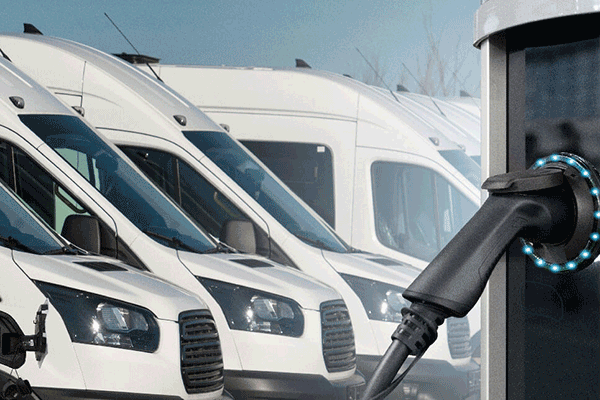Building a fleet of electric vehicles (EVs) can benefit your business and the environment. EVs are more efficient than gas-powered vehicles, resulting in lower operating costs and reduced emissions. Additionally, with the increasing availability of public charging infrastructure, it’s becoming easier to incorporate EVs into a fleet.

Benefits of building an EV fleet
Lower Fuel Costs
It’s hard to say exactly how much you’ll save in fuel costs, as the price of both gasoline and electricity fluctuate, but a 2020 Consumer Reports study says EV owners in every state will save money on fuel compared to ICE owners, with the national average on fuel savings being 60%.
These numbers come from studies that only look at personal vehicle use, but it’s safe to assume that the fuel savings will carry over to fleet vehicles, as well.
Off-peak charging
Over the years, the fuel price has fluctuated, but the cost of electricity has remained stable year after year. You can further reduce your charging costs by charging your vehicle during off-peak hours. Many cities offer discounted rates for charging during the least busy times on the grid (usually at night, on weekends, and on holidays). Your local power company may also offer special commercial rates for EV charging.
Lower maintenance costs
EVs have fewer moving parts than ICE vehicles, and fewer moving parts mean fewer opportunities for parts to break. Add in the fact that EVs also don’t require oil and other fluid changes, which means that EVs are cheaper to maintain than ICE vehicles.
The benefits of building a fleet of electric vehicles are apparent, so how exactly do you get started? Here are some steps to help you get started.
- Assess your needs: Before you start building your fleet, it’s important to assess your specific needs and requirements. Consider factors such as the types of routes your vehicles will be driving, the distance they will be traveling, and the amount of cargo they will be carrying. This will help you determine the right mix of vehicles for your fleet.
- Research available models: Once you have a good understanding of your needs, you can start researching the various EV models that are available. Take into account factors such as range, charging time, and overall cost. Some popular options include the Tesla Model 3, the Chevrolet Bolt, and the Nissan Leaf.
- Consider charging infrastructure: One of the key considerations when building a fleet of EVs is the charging infrastructure. While many public charging stations are available, it may be worthwhile to invest in on-site charging for your fleet. This will ensure that your vehicles are always ready to go and reduce downtime. Here we recommend our professional partner, SETEC POWER.
- Calculate the cost savings: Switching to EVs can save your business money on fuel costs and maintenance. Use a cost calculator to determine the potential savings for your fleet, and consider any government incentives that may be available to help offset the initial cost of purchasing EVs.
- Develop a plan for transitioning to EVs: Once you’ve done your research and calculated the potential cost savings, it’s time to develop a plan for transitioning your fleet to EVs. This may involve purchasing new vehicles, retrofitting existing vehicles, or a combination of both. Be sure to consider the logistical challenges of transitioning to EVs, such as training your staff and implementing new processes.
While it’s true that EVs do generally cost more to purchase up front, the true savings are in the long game and total cost of ownership. They are good for the environment, and they show that your company is environmentally responsible, and in some ways, they are a great marketing tool.














